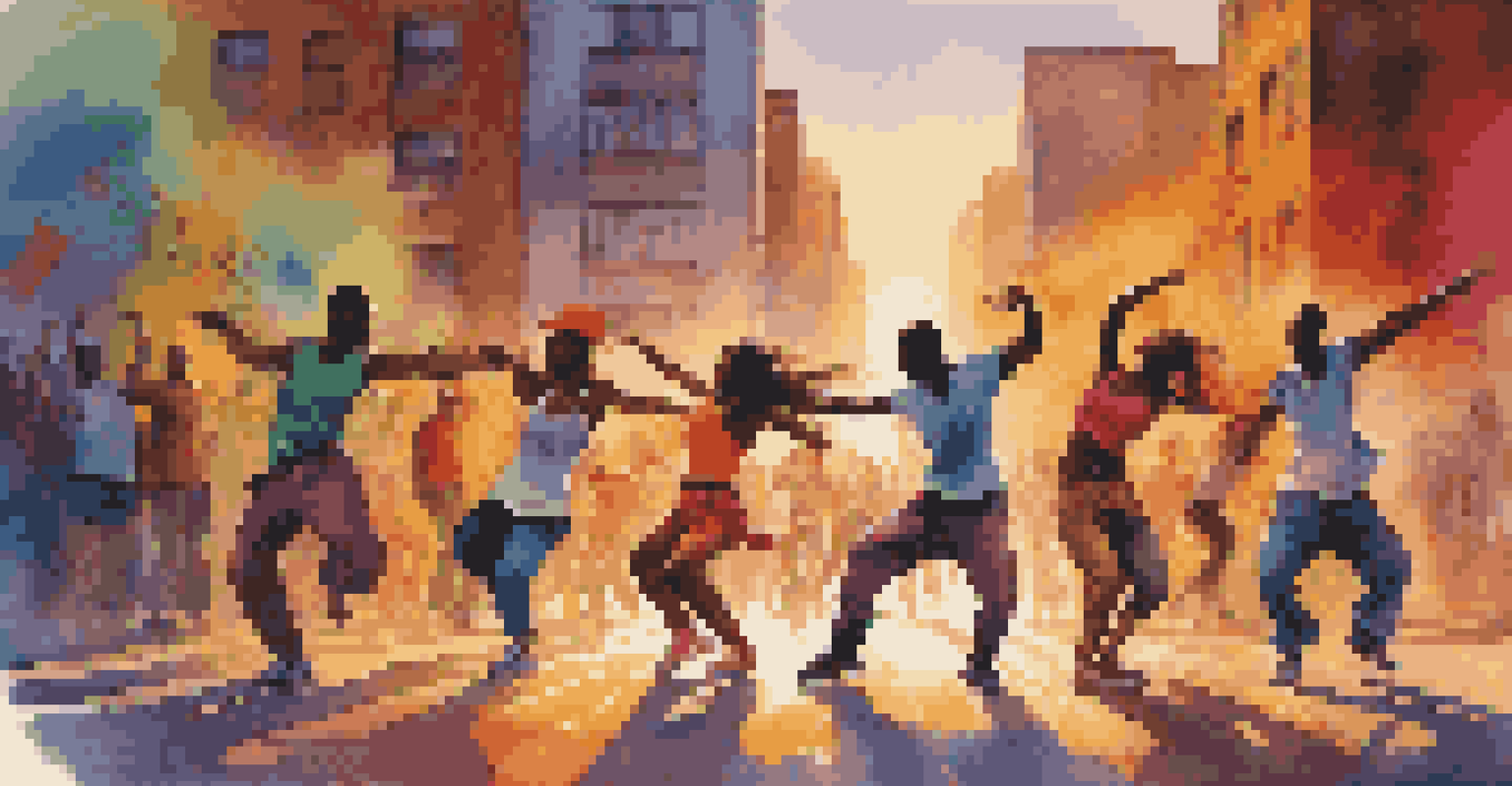The Power of Dance: Communicating Social Issues Without Words

Dance as a Universal Language of Expression
Dance serves as a universal language, transcending cultural and linguistic barriers. It allows individuals to express feelings and ideas that may be hard to articulate with words. Imagine watching a dancer pour their heart into every movement—this raw emotion can convey messages that resonate deeply with audiences, regardless of their backgrounds.
Dance is the hidden language of the soul.
Whether it’s a joyful celebration or a somber reflection, the rhythm and movement communicate a spectrum of human experiences. For instance, a solo dancer performing a heartfelt piece about loss can evoke empathy from viewers who might not share the same language or culture. This shared emotional experience is what makes dance a powerful tool for social commentary.
Moreover, the physicality of dance can illustrate complex social issues, making them accessible to a broader audience. When people witness the struggles and triumphs portrayed through dance, they may be inspired to engage with those issues on a deeper level, fostering a sense of understanding and connection.
Historical Context: Dance as Protest
Throughout history, dance has been used as a form of protest and resistance against social injustices. For example, the civil rights movement saw dancers use their art to challenge racial discrimination and inequality. These movements became not only a means of expression but also a rallying cry for change, showcasing the power of collective action.

Consider the iconic performance of 'The Black Ritual' by the Alvin Ailey American Dance Theater, which highlighted the struggles and resilience of African Americans. This piece encapsulated the pain of oppression while celebrating the strength of the community, effectively using dance to address profound societal issues.
Dance as a Universal Expression
Dance transcends cultural barriers, allowing individuals to convey emotions and ideas that words cannot express.
Similarly, contemporary dance companies continue this tradition, exploring themes like gender equality, environmental concerns, and mental health. By incorporating these themes into their performances, they encourage audiences to reflect on these pressing issues, proving that dance can be a catalyst for social awareness.
Choreographers as Social Commentators
Choreographers often assume the role of social commentators, using movement to address current events and societal issues. Through their creative lens, they can challenge norms and provoke thought, inviting audiences to engage with topics that may be uncomfortable or overlooked. For instance, choreographers like Pina Bausch and Martha Graham have explored themes of gender dynamics and human relationships in their works, sparking conversations around these issues.
The body says what words cannot.
By deliberately crafting movements that reflect societal realities, choreographers can highlight struggles such as immigration, poverty, and discrimination. Their choreography often acts as a mirror, reflecting the world around us and urging viewers to confront the realities they may prefer to ignore.
Moreover, their work encourages collaboration with other artists, activists, and communities, which amplifies the impact of their message. This collaborative spirit not only enriches the dance but also deepens the dialogue around pressing social issues, demonstrating the interconnectedness of art and activism.
The Influence of Dance in Popular Culture
Dance has a profound influence on popular culture, often serving as a vehicle for social commentary. From viral dance trends on social media to choreographed performances in music videos, dance shapes how we perceive and discuss societal issues. Artists like Beyoncé and Kendrick Lamar have incorporated powerful dance sequences in their work, addressing themes like racial identity and empowerment.
These performances resonate with audiences, sparking conversations beyond the stage or screen. For example, Beyoncé’s 'Formation' video, filled with evocative imagery and powerful choreography, addresses issues of race and police brutality, igniting discussions across various platforms. Such performances illustrate how dance can inspire movements and create a sense of community around shared causes.
Dance as a Tool for Social Change
Throughout history, dance has served as a powerful form of protest, addressing social injustices and fostering community engagement.
Additionally, popular dance competitions and shows like 'So You Think You Can Dance' often feature routines that tell stories about social issues. These platforms provide an opportunity for emerging dancers to express their perspectives, ensuring that the conversation about important topics continues to thrive in the public eye.
Dance Therapy: Healing Through Movement
Beyond social commentary, dance also serves as a form of therapy, helping individuals cope with personal and societal challenges. Dance therapy integrates movement with emotional expression, providing a safe space for participants to explore their feelings and experiences. This therapeutic approach can be particularly beneficial for those affected by trauma, allowing them to process their emotions non-verbally.
For many, the act of dancing can liberate suppressed emotions and foster a sense of empowerment. Consider the stories of survivors of abuse who find healing through expressive dance, transforming their pain into powerful movements that reclaim their narratives. In this way, dance becomes a tool not just for expression, but for personal and communal healing.
As mental health awareness grows, the recognition of dance therapy's benefits is also increasing. Programs that incorporate dance into mental health initiatives are emerging, showcasing how movement can bridge the gap between emotional expression and healing, ultimately addressing broader social issues like mental health stigma.
Global Perspectives: Dance as a Social Tool
Across the globe, various cultures use dance as a tool for social engagement and activism. In many indigenous communities, traditional dances serve to preserve cultural identity while addressing contemporary issues such as land rights and environmental sustainability. These performances often tell stories of resilience and connection to the land, reinforcing the importance of cultural heritage in the face of adversity.
Take, for instance, the traditional dances of the Maori people in New Zealand, which not only celebrate their culture but also address social issues like colonization and cultural appropriation. These dances keep the conversation alive, ensuring that history is acknowledged and that future generations are aware of their roots.
Healing Through Dance Therapy
Dance therapy offers a safe space for emotional expression, helping individuals cope with trauma and promoting mental health.
In urban settings, street dance and hip-hop culture have emerged as powerful forms of protest. Dancers use their skills to raise awareness about social justice issues, often performing in public spaces to engage passersby. This grassroots approach to activism through dance demonstrates its ability to unite communities and inspire action on a local and global scale.
The Future of Dance in Social Advocacy
Looking ahead, the role of dance in social advocacy is likely to expand, driven by technological innovations and evolving social landscapes. Virtual performances and online platforms have emerged as new avenues for dancers to share their messages, reaching wider audiences than ever before. This accessibility means more voices can contribute to the dialogue around pressing social issues.
Furthermore, the integration of dance with other art forms, such as film and digital media, allows for innovative storytelling that can amplify social messages. By collaborating with filmmakers or visual artists, choreographers can create multimedia experiences that engage and educate audiences on various issues.

As the world continues to grapple with complex challenges, dance will remain a vital form of expression and advocacy. By harnessing the power of movement, artists can inspire change, foster understanding, and connect with communities, proving that dance is not just an art form but a vital force for social good.